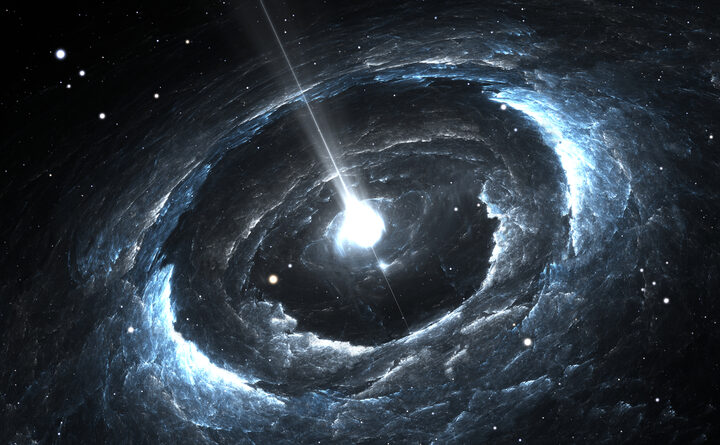
Fast radio bursts (FRBs) are radio signals that last just a few milliseconds. Most appear to be coming from deep space. What causes them is unknown, but whatever their source it must be highly energetic — producing as much energy in a millisecond as the sun does in 80 years.
The first FRB was discovered over 20 years ago, and since then dozens have been discovered, with concentrated efforts to understand what has been causing them to occur over recent years. Initially, it was thought that a one-off, cataclysmic event, such as the collision of two neutron stars, may be behind them. But this was thrown into doubt when scientists identified a FRB that appeared to repeat: FRB 121102. These bursts had previously been traced back to a dwarf galaxy three billion light-years away.
For the last four years, scientists have been monitoring FRB 121102 to find a pattern in the bursts. In a study published in the Monthly Notices of the Royal Astronomical Society, researchers led by Kaustubh Rajwade, from the U.K.'s University of Manchester, have now found these bursts appear to repeat on a 157-day cycle.
By looking at 32 bursts over the study period, along with previous research on the burst, they found the FRB is emitted in a 90-day window then goes quiet for 67 days.
"We predict that the source is currently 'off' and that it should turn 'on'" again at some point between June 2 and August 28, they wrote. "We are hoping to monitor the source now to see if our predictions hold," Rajwade told Newsweek in an email.
Only one other repeating FRB has been found with a regular pattern. FRB 180916.J10158+56 repeats on a cycle lasting roughly 16 days — around 10 times shorter than the cycle of FRB 121102.
"Overall, repeating FRBs tell us that the source that produces them is not destroyed in the process. Moreover, a detection of periodicity in the burst activity hints at orbital motion. This provides strong constraints on models that can explain such a periodicity."
Previously, scientists have said neutron stars may be producing FRBs. Neutron stars are the remnants of collapsed massive stars that explode as supernovas. They are incredibly dense objects, containing between 1.3 and two times the mass of the sun into a space around 15 miles wide. According to NASA, a teaspoon of material from a neutron star would weigh about the same as Mount Everest.
The discovery of FRB 121102's 157-day cycle places constraints on the idea of neutron stars as a source, Rajwade said. "The detection of a periodicity in bursting suggests that the source producing these FRBs potentially could be in an orbit with another astrophysical object. Another possible explanation is that if we assume that FRBs are produced from the magnetic poles of highly magnetized neutron stars, then such a periodicity can arise from the rotation of the magnetic pole just like a wobbling top — this motion is called precession.
"It can be difficult to explain a 157 day periodicity just by precession of the magnetic axis of a neutron star but it cannot be ruled out completely. As far as FRB 121102 is concerned, I believe that a neutron star with [a] high magnetic field is a very good candidate for its source."
Ryan Shannon, from Australia's Swinburne University of Technology, who studies FRBs but was not involved in the latest research, said finding "periodicity" for FRB 121102 would be a "game changer" as it gives more information on the source.
"The result is tentative, but the great thing is that it is imminently testable," he told Newsweek in an email. "The paper makes predictions about when the source should be active and when it should be quiet. In fact, the paper predicts the next active period started about a week ago (June 2). The giant FAST radio telescope in China has seen many bursts from the source. If it were to see bursts when the authors claim the burst is inactive it would suggest the periodicity was in fact spurious.
"The big question is how FRB 121102 relates to other FRBs, including many that have not been seen to repeat...Very few FRBs have been found to repeat. Is there more than one way to produce an FRB? Is periodicity necessary, or will it end up being a red herring in our quest to understand what produces the bursts? The field is moving rapidly. However, every question answered seems to raise others."
The U.K.'s Lovell telescope, which was being used to monitor FRB 121102, is currently closed because of the coronavirus pandemic. Rajwade said it is hoped it will be back online in around a month's time. "We plan to continue our monitoring of FRB 121102 and other repeating FRBs," he said. "If our predictions hold true, it will just show the importance of monitoring other repeating FRBs to search for signatures of periodicity in their bursting activity as it may hold clues for finding the true nature of FRBs."



Reader Comments
to our Newsletter